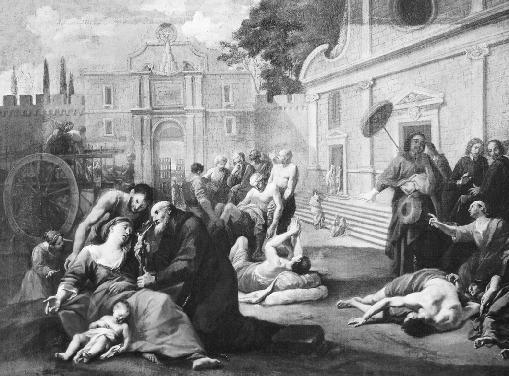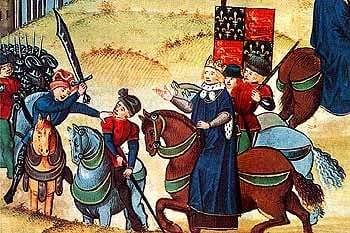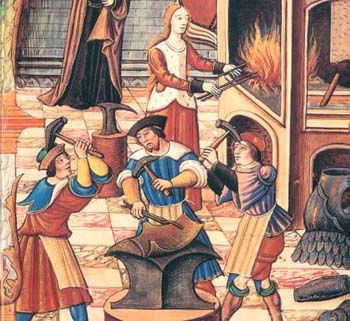I. Rural Growth and Crisis
A. Peasants, Population, and Plague
1. Rural life--In 1200, most western Europeans lived as serfs tilling the soil on large estates woned by the nobility and the Church. They owed their lord a share of both their harvests and numerous labor services. As a consequence of the inefficiency of farming practices and their obligations to landowners, peasants received meager returns for their hard work. Even with the numerous religious holidays, peasants labored fifty-four hours a week in their fields, more than half that time in support of the local nobility. Each noble household typically lived on the labor of fifteen to thirty peasant families.
2. New Farming Technology--Population growth required more productive farming and new agricultural settlements. The new three-field system replaced the practice of leaving half the land fallow (unplanted) every year so it could regain its fertility. Instead, complimentary plants restored nutrients to the soil, and the fallow field allowed pasture for horses, who in turn produced fertilizer.
3. New Settlements--The Order of Teutonic Knights drove out native peoples who had not adopted Christianity, and resettled Christian peasants on the land in much of present day Germany; other Latin Christians were able to found new settlements on lands conquered from Muslim and Byzantines in southern Europe, and on Celtic lands in the British Isles.
4. Famines--the population explosion necessitated the draining of swamps and clearing of forests, opening more marginal land to settlement. With climatic change beginning about 1250, this land was more suceptible to frost, and after 1300 northern Europe could no longer depend upon warm summers. After 1300, most Europeans could expect to face extreme hunger once or twice during his (or her) 30 to 35 years of life.
5. Black Death--reversed this population growth. Brought to Kaffa by Mongol invaders, the disease was brought to Italy and southern France by Genoese traders in 1347. The disease spread throughout Europe for the next two years, in some places killing as much as two-thirds of the population. For Europe as a whole, about one-third of the population was killed.
B. Social Rebellion--the Black Death triggered social changes in western Europe, as workers who survived demanded higher pay for their services.
1. Wat Tyler Rebellion--In 1831, English peasants, under the leadership of one of their own, Wat Tyler, invaded London, demanding an end to serfdom and obligations to landowners. Demonstrators murdered the archbishop of Canterbury and several royal officials, and authorities responded with even greater violence and bloodshed--including the killing of the unarmed Tyler during a meeting with the King. These actions could not stave off the higher wages and other changes demanded by the rebels, however
2. Better Rural Conditions--Serfdom practically disappeared in western Europe after this time period, as serfs either ran away to cities (inhabitants became free in most cities in western Europe after living there one year), or purchased their freedom. Some large English landowners, no longer having enough serfs to work their landholdings, instead began raising sheep and providing wool to manufacturers in Flanders and, later, England. The Black Death had only effected human populations; so, those left had more to eat. The material conditions of the rural poor improved after the plague, although the gap between rich and poor was still huge.
C. Mills and Mines--Mining, metalworking, and the use of mechanical energy expanded so greatly in the centuries before 1500 that some historians speak of an "industrial revolution" in medieval Europe.
1. Watermills--Watermills were not, of course, a European invention, but before 1500 the landscape in much of western Europe fairly britstled with watermills. Because the watermills worked more efficiently if water dropped from above the wheel, many of the rivers in Europe were also dammed. In areas that were fairly arid, or where winter were severe enough that they froze over, windmills became favored. These mills provided power for a host of different activities.
2. Milling and Iron Making--watermills provided much of the power to break up iron ore, and to operate the bellows that superheated the fire that turned the iron into liquid.
3. Growth of Industry--Demand stimulated iron mining in many parts of Europe; in addition, new silver, lead, and copper mines in the region supplied metal for coins, church bells, cannon, and statues. Industrial growth changed the landscape: towns grew outward and new ones were founded, dams and canals changed the flow of rivers, quarries and mines were developed. Urban factories like tanneries, along with human waste from these cities, polluted the waterways. Deforestation accelerated, providing wood for ships, buildings, and as fuel in such endeavors as glass making.
II. Urban Revival
A. Trading Cities-Most urban growth after 1200 resulted from manufacturing and trade, both between cities and their hinterlands and over long distances. Northern Italy particularly benefited from maritime trade with port cities of the eastern Mediterranean, and, through them, the markets of the Indian Ocean and East Asia. In northern Europe, commercial cities in the county of Flanders (roughly today's Belgium) and around the Baltic Sea profited from regional networks and from overland sea routes to the Mediterranean.
1. The Fourth Crusade--Was not really a Crusade, but a Venetian-inspired attack on Constantinople, that temporarily eliminated Byzantine control of the Straits of Bosporus, and allowed Venice to seize control of Crete and expand its trading colonies around the Black Sea.
2. Marco Polo--A young Venetian merchant who traveled in 1271 overland via the Silk Road to China during the reign of Khubilai Khan. Polo served as an official in the Chinese government for Khubilai (he claimed), including a stint as a governor of a Chinese province, before returning to Europe via the Indian Ocean some twenty-four years after he began his journey.
3. Genoa and the Hanseatic League--Venice was not the only city in northern Italy that developed an extensive trade network; the sea trade conducted by Genoa was probably just as extensive, and in northern Europe among the members of the Hanseatic League, who traded mainly among the ports of the Baltic Sea, including as far east as Novogorod in Russia and London in England.
4. Flemish Cities and Textiles--In the late 13th century, Genoese galleys from the Mediterranean and Hanseatic ships from the Baltic were converging on the trading and manufacturing cities in Flanders. Artisans in Bruges, Ghent, and Ypres transformed wool from England into fine woolen cloth that was softer and smoother than the "homespun" cloth made in villages around the continent. Dyed in vivid colors, these Flemish textiles appealed to wealthy Europeans, who also were buying textiles from Asia
5. Trade Fairs--Venetians traded with these Flemish cities via an overland route, and in the Champagne region of France there developed trade fairs, where local merchants and farmers could trade their goods with each other, as well as with these Venetian traders going to and from Flanders. This trade became much more regular when the French king gained control of the Champagne region, and could guarantee safe passage for travelers. This trade expanded so much that it became cheaper to send ships from Venice, and the trade fairs declined in international importance, although they remained regionally important.
6. Wool Trade--In the late 13th century, the English king raised the tariff on exported raw wool, so that it became cheaper to manufacture woolen cloth in England--especially after a number of Flemish artisans moved to England and brought their knowledge of the trade with them. Florence, another city in northern Italy, also developed a home-grown textile industry.
7. Venice--While Venice first grew in importance as a trading center, by the 15th century it had also grown as a manufacturing center, turning out glassware and fine textiles that previously had only been available from Asian sources. Europeans were able to adopt innovations from other cultures readily, and make them their own.
B. Civic Life--Most northern Italian and German cities were independent states, much like the port cities of the Indian Ocean Basin. Other European cities held charters that exempted them from control of local nobles. This autonomy enabled them to adapt to changing market conditions more quickly than cities controlled by imperial authorities, as in China and the Islamic world. Since anyone who lived in a chartered city for over a year could claim freedom, urban life promoted social mobility.
1. Jews in Europe--Western Europe's Jews mostly live in cities. Spain had the largest number of Jews as a result of the religious tolerance practiced by the Muslim rulers there. Most commercial cities welcomed Jews with manufacturing and business skills; however, during times of crisis (like the Black Death), Jews were blamed and persecuted. In 1492, and Isabel and Ferdinand were consolidating their control of modern-day Spain, they ordered all Jew expelled from the kingdom.
2. Artisan Guilds--Within most towns and cities, powerful associations known as guilds dominated civic life. Guilds brought together craft specialists or merchants working in a particular trade to regulate business and to set prices. Guilds also trained apprentices and promoted members' interests in the city government. Guilds denied membership to certain people (especially Jews), and protected the interests of families of members.
3. Banking--By the fifteenth century, a new class of wealthy merchant bankers was operating on a vast scale and specializing in money changing and loans and making investments on behalf of other parties. Some merchant-bankers even developed their own news service, gathering information on any topic that could affect business. The Medici family of Florence operated banks in their hometown, as well as in Florence and London--and became important enough that one of the members of the family became Pope. The holding of the Medici's paled in comparison to the Fugger family by 1500, however, as that family's holdings was as much as ten times larger. The Fugger's financed various activities, including Hungarian copper mining.
C. Gothic Cathedrals--The men who designed and built the cathedrals had little or no formal education and a limited understanding of mathematics or of modern civil engineering. Master masons sometimes miscalculated, causing parts of some overly ambitious parts of cathedrals to come tumbling down. But as builders gained experience and invented novel solutions to their problems, success rose from the rubble of their mistakes.










WORLD HISTORY. WOO.
ReplyDeleteMAH FAVORITE.
DeletePLEASE SOMEONE REPLY TO THIS SO I KNOW THAT OTHER PEOPLE HAVE LOOKED AT THIS.
DeleteI looked at this, thanks!
DeleteVery interesting read!
ReplyDelete